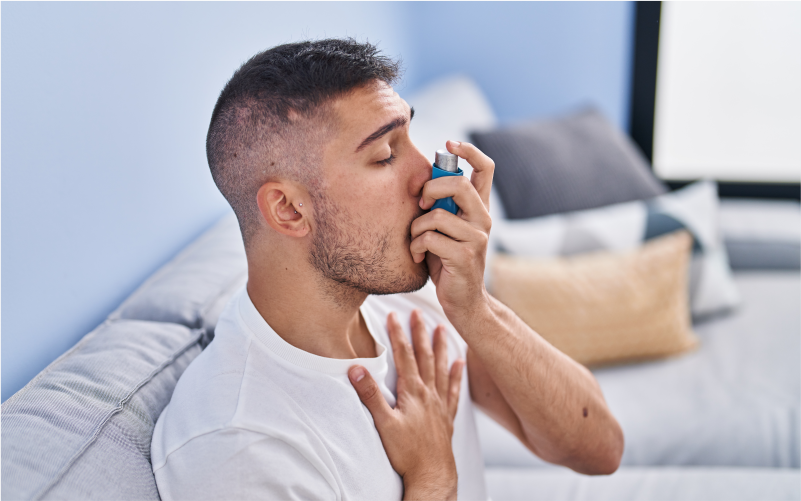Introduction
Asthma, also called bronchial asthma, is a disease that affects your airways & lungs. It’s a chronic condition, meaning it doesn’t go away and needs ongoing medical management. When you breathe normally, muscles around your airways are relaxed, letting air move easily and quietly. TX is the one of the best hospital for asthma treatment

During an asthma attack, three things can happen
- Bronchospasm: The muscles around the airways constrict (tighten). When they tighten, it makes your airways narrow. Air cannot flow freely through constricted airways.
- Inflammation: The lining of your airways becomes swollen. Swollen airways don’t let as much air in or out of your lungs.
- Mucus production: During the attack, your body creates more mucus. This thick mucus clogs airways.
Asthma is broken down into types based on the cause and the severity of symptoms.
- Intermittent: This type of asthma comes and goes so you can feel normal in between asthma flares.
- Persistent: Persistent asthma means you have symptoms most of the time. Symptoms can be mild, moderate or severe. Healthcare providers base asthma severity on how often you have symptoms. They also consider how well you can do things during an attack.
Asthma has multiple causes:
- Allergic: Some people’s allergies can cause an asthma attack. Allergens include things like molds, pollens and pet dander.
- Non-allergic: Outside factors can cause asthma to flare up. Exercise, stress, illness, aspirin pregnancy and weather may cause a flare.
What causes asthma?
- Allergies: Having allergies can raise your risk of developing asthma.
- Genetics: If your family has a history of asthma or allergic diseases, you have a higher risk of developing the disease.
- Respiratory infections: Certain respiratory infections, such as respiratory syncytial virus (RSV), can damage young children’s developing lungs.
- Air pollution: Many things outside can cause an asthma attack. Air pollution includes factory emissions, car exhaust, wildfire smoke and more.
- Dust mites: You can’t see these bugs, but they are in our homes. If you have a dust mite allergy, this can cause an asthma attack.
- Exercise: For some people, exercising can cause an attack.
- Mold: Damp places can spawn mold, which can cause problems if you have asthma. You don’t even have to be allergic to mold to have an attack.
- Pests: Cockroaches, mice and other household pests can cause asthma attacks.
- Pets: Your pets can cause asthma attacks. If you’re allergic to pet dander (dried skin flakes), breathing in the dander can irritate your airways.
- Tobacco smoke: If you or someone in your home smokes, you have a higher risk of developing asthma. You should never smoke in enclosed places like the car or home, and the best solution is to quit smoking. Your provider can help.
- Strong chemicals or smells. These things can trigger attacks in some people.
- Certain occupational exposures. You can be exposed to many things at your job, including cleaning products, dust from flour or wood, or other chemicals. These can all be triggers if you have asthma.
What are the symptoms of asthma?
People with asthma usually have obvious symptoms. These signs and symptoms resemble many respiratory infections:
- Chest tightness, pain or pressure.
- Coughing (especially at night).
- Shortness of breath.
When to see a doctor:
If you’re witnessing any unusual signs, you should meet with your primary care doctor. Only after a medical exam, your overall condition can be assessed. They may refer you to a pulmonologist if you, Visit TX Hospital provides the best treatment for Asthma in hyderabad.
- have difficulty breathing
- have a persistent cough
- regularly cough up blood or mucus
- smoke
- have unexplained weight loss
- have trouble exercising due to breathing problems
Asthma Treatment:
Treatment options for asthma are increasing and improving. The goal of treatment is to:
- help a person breathe better
- reduce the number of attacks
- increase the number of activities they can engage in
A person should work with a healthcare professional to develop the most suitable treatment plan for them. Some current options for treatment include quick-relief medication and long-term control medications. Quick-relief medications help alleviate symptoms, while long-term control medication reduces the number of attacks if a person takes it daily.
Asthma medications currently include
- long- and short-term bronchodilators that relax muscles in the airways
- antibiotics for a bacterial pneumonia or bronchitis
- anti-inflammatory medications, such as inhaled corticosteroids, for long-term maintenance, or oral steroids for an acute attack a combination of bronchodilators and corticosteroids







